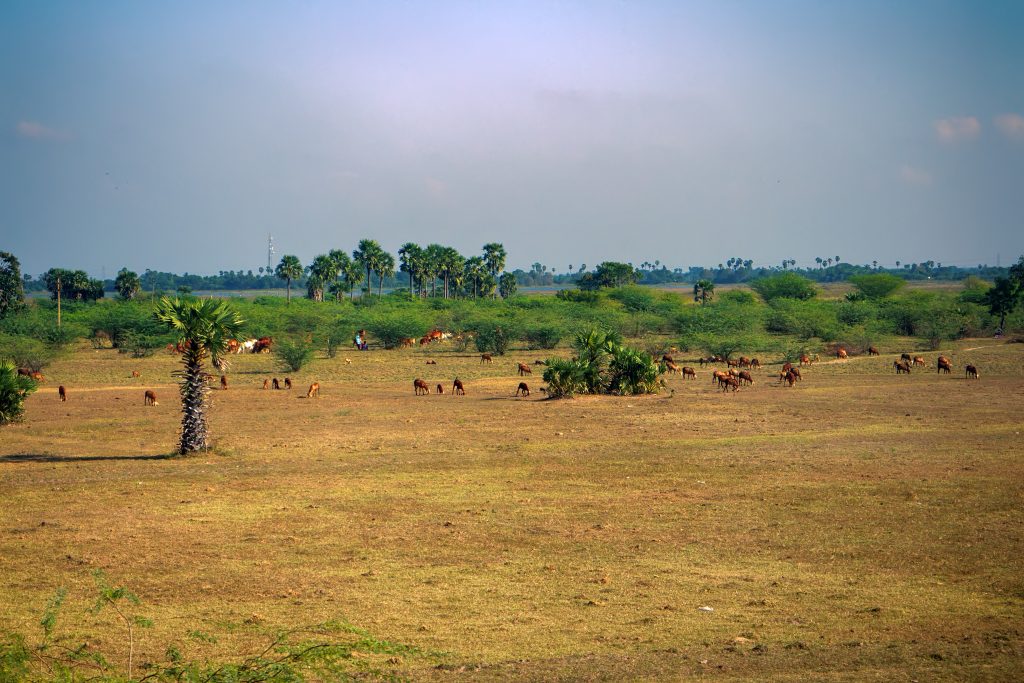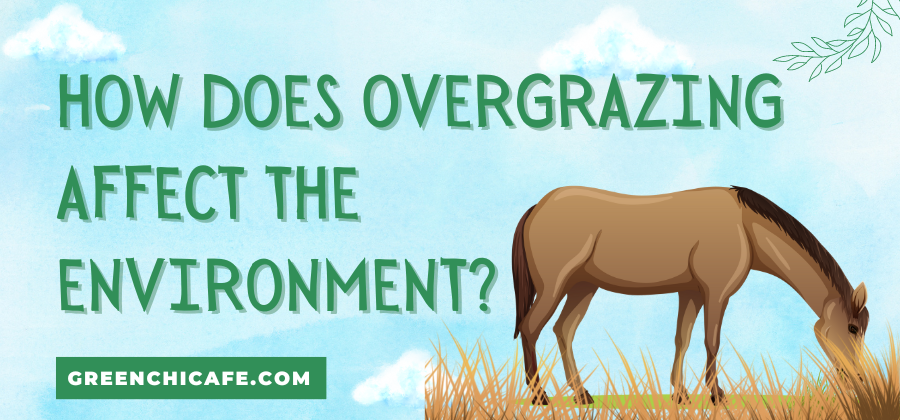Understanding the consequences of overgrazing provides insight into more sustainable grazing practices.
While grazing livestock can be compatible with healthy ecosystems, overstocking pastures triggers a cascade of environmental harm.
Careful monitoring and adaptive management are key to preventing irreversible rangeland degradation.
How Does Overgrazing Affect the Environment?

Overgrazing degrades ecosystems through soil erosion, vegetation loss, water pollution, and desertification.
It damages rangeland health and biodiversity by exceeding capacities for grazing intensity and duration.
Preventing overgrazing through sustainable stocking rates and grazing rotation is key to avoiding these detrimental environmental impacts.
Key Points
- Overgrazing removes protective plant cover, spurring soil erosion.
- Nutrient and sediment runoff pollute waterways, harming aquatic life.
- Habitat loss threatens wildlife populations like sage grouse and pygmy rabbits.
- Accelerated desertification can permanently alter grasslands into unproductive wastelands.
What Causes Overgrazing of Grasslands?
Overgrazing arises from having too many animals grazing an area for too long without adequate rest periods.
It reflects poor grazing management, not inherent flaws in grazing systems.
Contributing factors include:
Running more livestock than the land can support through its primary production.
Not rotating livestock to give grazed areas time to recover.
Returning animals while grasses are still stressed from prior grazing.
Grazing during droughts or winter when plants are dormant.
Using the same grazing areas year after year without rotation.
Overcoming the tragedy of the commons dilemma through collective action could help avoid overgrazing shared pastures.
But often economic or social pressures lead to individual maximization of grazing beyond sustainable levels.
How Does Overgrazing Cause Soil Erosion?

Excessive livestock trampling and grazing removes protective plant cover and damages biological soil crusts.
This leaves the soil vulnerable to erosion from wind and rainfall.
Grazers also compact soils, reducing water infiltration and increasing runoff that carries sediments.
Nutrient losses occur as topsoil erodes.
Lower soil fertility and poorer water retention then inhibit plant regrowth.
This sets up a negative cycle where thinning vegetation exposes more soil to erosion.
Overgrazed areas can lose up to 35 times more soil than properly grazed pastures.
What Effects Does Overgrazing Have on Water Quality?
Overgrazing contributes to numerous issues of aquatic habitat and water quality decline:
Increased runoff from compacted soils elevates sediment loads in streams, damaging the aquatic environment and degrading fish spawning habitat.
Sediments also carry livestock fecal bacteria like E. coli into waterways, posing health risks.
Loss of streamside vegetation removes filtration for pathogens and agricultural chemicals in a runoff.
Higher water temperatures occur as streams widen from accelerated bank erosion, harming aquatic life.
Nutrient loads increase, promoting algal blooms and eutrophication that deplete dissolved oxygen.
Lower water tables develop from reduced infiltration on degraded lands.
Proper management like rotational grazing and riparian buffers prevents overgrazing and damage to water resources.
But uncontrolled overgrazing severely degrades downstream hydrology, ecosystems, and human health.
How Does Overgrazing Affect the Carbon Cycle?
Overgrazing’s impacts on soil and vegetation carbon sequestration may enhance greenhouse gas emissions and climate change.
Hoof trampling and vegetation loss reduce carbon stored in soils and biomass.
Compaction also limits plant growth and carbon dioxide uptake.
However, some studies suggest mob grazing at very high stock densities may boost soil carbon.
Outcomes likely depend on site-specific conditions and grazing practices.
But preventing overgrazing is widely agreed to maintain rangeland carbon storage.
Modeling on the Great Plains estimated transitioning conventionally grazed lands to rotational grazing could sequester over 30 million additional tons of soil carbon.
Can Overgrazing Lead to Desertification?
Yes, overgrazing is a major driver of desertification worldwide – the process whereby fertile grasslands transform to desert through climate and human activities.
Overgrazing stresses vegetation during dry periods, sometimes killing plants outright.
Loss of plant cover exposes soils to erosion while also decreasing soil moisture and fertility.
This makes recovery increasingly difficult.
Shrub and weed encroachment occurs as desirable grasses decline.
The degraded landscape has lower water infiltration and holding capacity, facilitating self-reinforcing drying feedback.
Without intervention, the cascade initiated by overgrazing can permanently transform grasslands into unproductive desertified wastelands.
How Does Habitat Loss From Overgrazing Affect Wildlife?
Overgrazing-induced habitat degradation threatens wildlife, including vulnerable sage grouse, pygmy rabbits, and desert tortoises in Western U.S. rangelands.
Loss of forage and hiding cover stresses populations. Declining habitat quality and connectivity also threaten wide-ranging pronghorn antelope.
Increased erosion and runoff degrade aquatic habitats essential for native trout and amphibians.
Restoring overgrazed areas by planting native vegetation and limiting grazing supports biodiversity conservation.
But preventing overgrazing from occurring in the first place is more effective, as habitat restoration can be challenging.
What Does Overgrazing Lead To?
Overgrazing triggers a cascade of harmful environmental impacts:
Vegetation loss as palatable plants are preferentially grazed and trampled below reproductive thresholds.
Accelerated soil erosion as the protective cover is removed, exposing the soil to wind and rainfall detachment.
Nutrients are lost.
Weed and shrub encroachment since native grasses decline.
This reduces livestock forage quality over time.
Desertification feedback as degraded lands has lower water infiltration, facilitating drying.
Fertile grasslands convert to deserts.
Declining biodiversity as habitat loss and degradation stresses native wildlife populations like sage grouse and pronghorn.
Water pollution as sediments, fecal bacteria, and agricultural chemicals wash into streams, degrading aquatic ecosystems.
Enhanced carbon emissions as biomass carbon storage declines while nitrous oxide releases increase from compacted soils.
This exacerbates climate change.
How is Overgrazing Affecting Grasslands?
Overgrazing is one of the most significant threats to grassland health worldwide.
Effects on grasslands include:
Declines in native grass cover lead to weed and shrub encroachment.
Unpalatable plants dominate.
Reduced carbon storage and greenhouse gas emissions as thinning vegetation decreases biomass.
Lower biodiversity as wildlife populations decline without adequate vegetation cover and food sources.
Increased surface runoff and soil erosion from trampling and bare ground, degrading downstream water quality.
Desertification feedback is triggered during periods of drought, converting grasslands to sparse, infertile desert scrublands.
Fragmentation of intact grasslands by overgrazed patches, roads, and cropland conversions.
This leaves less habitat for sensitive wildlife species.
Increased costs for supplemental hay feeding of livestock as forage quality and availability decrease on degraded pastures.
When Did Overgrazing Become a Problem?
Overgrazing arose primarily in the 19th century as settlers populated North America’s prairies and grazed large livestock herds without regard for range conditions.
The lack of natural predators like wolves and policies promoting unregulated open grazing contributed to overstocking and subsequent rangeland deterioration.
The Dust Bowl conditions of the 1930s spotlighted the massive erosion and devastation possible from excessive grazing and plowing without soil conservation practices.
Overgrazing persists worldwide today, though scientific range management has demonstrated ways to graze livestock sustainably while avoiding overgrazing if applied properly at management scales.
But social, political, and economic hurdles continue to favor short-term production over proper stewardship in some regions.
Key Takeaways:
- Overgrazing has far-reaching detrimental consequences for soils, vegetation, water, carbon storage, desertification risk, and wildlife habitats.
- Sustainable grazing practices and maintaining plant communities are vital for ecological health.
FAQ
What Is Sustainable Grazing?
Sustainable grazing balances stocking densities and grazing duration to maintain plant communities. Rotational grazing prevents overgrazing damage by allowing pasture rest and recovery.
What Is Biological Soil Crust?
The biological crust comprises mosses, lichens, bacteria, and fungi living on soil surfaces. This crust stabilizes soils but is damaged by excess trampling.
How Does Overgrazing Increase Erosion?
Removal of plant cover and compaction leave soil vulnerable to erosion from rainfall and wind. Loss of topsoil degrades land productivity further.
GreenChiCafe provides sustainability tips for eco-friendly living.
Visit our site to learn more about regenerative grazing practices.
